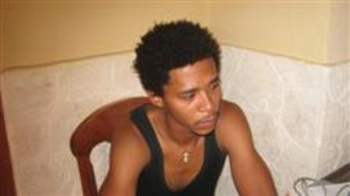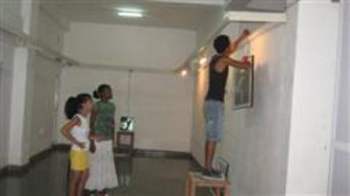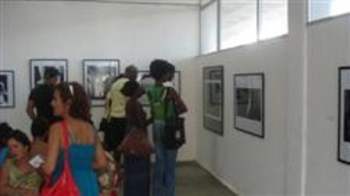Cuban Artist Looking Inwards
Yusimí Rodríguez

HAVANA TIMES, June 14 – Those who come to the Her-Car (Hernández Cárdenas) Gallery, located at the intersection of Porvenir and Diez de Octubre Avenue in the capital, will think that the site has been converted into an X-Ray laboratory. The walls have been covered with radiographic images, a technique employed by the artist Yomer Fidel Montejo Harrys. His show, titled “Desgaste” (Wear and tear) was inaugurated on Friday, June 3 at 6 pm and can be visited until the 20th of this month. The gallery is open from Tuesday through Sunday.
Desgaste is the first individual exhibition of this young 28-year-old artist who has previously participated in several group expositions: “Extase” in September of 2010 in the Mariano Rodriguez Gallery on Villa Panamericana of the East Havana municipality, “Blades of Silk”, in November-December of 2010 at the Luz y Oficios Gallery; and at the Centro Provincial de Artes Plásticas y Diseño [the Provincial Art and Design Center] in Old Havana.
He also obtained an Honorable Mention in the VI Art Salon: Panorama 42, held at the Wilfredo Lam Gallery of the Marianao municipality from December 2008 through January 2009; Third Prize in the II Biennial La Llave del Cerro [Key to the Hill] held in October of 2009 at the Teodoro Ramos Gallery of that same municipality and was a finalist in the Erotic Art Salons of the Fayad Jamís Gallery in the municipality of East Havana, during 2008 and 2010. His works were included in the Latin American Photography Salon during the 2011 event, “City in Movement”. Just a few months ago he became a member of the Hermanos Saíz Association which groups together young artists in the country.
Nevertheless, this young artist who is now beginning to earn a name for himself, is not a graduate of San Alejandro nor of any other school of art. In 2000 he graduated as an Artisan from the Civil Construction and Crafts School “Pablo de la Torriente Brau”. Seven years later, he graduated from a course of study in imaging and became a health technician. In the last three years he has broken into the artistic world with his technique of radiological photography.

Through this technique, as Cristina Padura writes in the exhibition’s catalogue. “He introduces a series of representations which penetrate into the interior of his models, using authentic X-Ray pictures which bring him close to clinical discourse as a form of art, in conjunction with cold and exquisite objects, symbols of the innate violence of contemporary civil life, an ironic recreation with everyday actions…”
Thanks to a mutual friend that I interviewed for HT last year, I was able to meet with Yomer on the very day before the show. At that moment he was busy mounting the exhibition and arranging things with the curators, so that he barely had time for two words with me. Two days later, once the tension of inaugurating his first solo exhibition had passed, we were able to sit down and converse more calmly.
HT: Tell me how you began to use this technique of radiographic photography to express your art, and what it consists of.
Yomer: This work has taken me two or three years of experimentation to develop, without knowing if it could or could not be developed as a form of art. I spent two years working in a clinic as an X-ray technician, and that’s how I began. I would bring any kind of object – a piece of iron, something that I had brought from home – to the department and I would put it on one of the plaques. Sometimes I would take an X-ray of my own hand. It came about like that, with no intention of creating art or converting it into something proffesional.
Later I began consulting books and magazines and delving deeper into this kind of work. I began to focus on things that interested me conceptually about the people, and to express them through elements that I incorporated into the X-ray images. The technique went on developing in this way. I was also able to obtain a little more background information and to see some work that other foreign artists had produced with this technique. I began to take it more seriously.
HT: So, before developing this technique, you hadn’t had any other experiences in the world of art?
Yomer: Yes I had. In the year 2000, I graduated with a mid-level vocational degree in handicrafts. I’ve always liked the arts, particularly drawing and sculpture, in ceramics or with other materials. But I’ve always wanted to go a little beyond that and experiment, try to find myself in whatever felt good to me and develop a serious body of work.

I began to present my work in some salons, the Salon of Erotic Art in Alamar, the Llave del Cerro – these are gatherings that certain galleries put together involving both professional artists and non-graduates. I was awarded some prizes and honorable mentions and things began to flow. Some friends told me that my work was good but that I should be taking it more seriously, and they put me in contact with artistic projects….What I do is to take an element that has a conceptual significance for me and put it into the X-ray with the person.
HT: What is the meaning of the exhibition’s title, “Degaste” (Wear and tear)?
Yomer: At first I tried to find some titles for the work that I was doing to express the concept of why should we see radiography, which reveals the internal parts of a human being, as an art form. And “Wear and Tear” for the things that I see every day and for those that happen to me as well, people go on wearing away.
It could refer to the wear on an object, but I wanted to allude to the physical and mental wearing away of a human being due to the problems that they have… In the romantic aspect as well, like in the piece titled “The Kiss”, even though it looks somewhat erotic and romantic, a couple also suffers wear and tear. It’s about the wear that human beings suffer with violence, misery, everything.
HT: Photographs that show the exterior of things don’t interest you, only the internal facet of the person?
Yomer: Up until now, yes, I’m interested in the internal part because I believe that it’s where the problem is. We can see something superficially and think that it’s fine, but inside it’s not that way at all.
HT: What problems are you referring to?
Yomer: Physical and psychological problems that people can suffer.

HT: But you can’t see these in an X-ray – or can you?
Yomer: They can’t be seen, but I try to bring them into focus through the different elements that I incorporate into the X-ray plaques. As you can see, I use objects from everyday life and add them to a bony part, such as a cranium, a foot, a pelvis, a hip… I see that there are problems which could be my own and not other people’s, or vice versa. But I try to get people focused on that and to ask themselves, “Why did he show the bony part of the person, or the internal view of an object?”
HT: My attention was especially drawn to the piece, “Slaves of the present” where you can see feet – a woman’s I suppose – on high heels and hooked to some shackles. What are you trying to convey with this piece?
Yomer: I wanted to show prostitution and the resulting wearing away that it produces in a person, be it a man or a woman. People can interpret it as a woman’s feet, but it could also be a man’s. To me it’s both things – man and woman. In my work, I don’t always make clear if it’s a man a woman or a child.
HT: What’s your interest in prostitution?
Yomer: It’s not that it interests me, but what I see of it shocks me. The wear that these people suffer is extreme, to the point that they come to feel themselves enslaved by it, by their work, their own form of thinking, their method of survival. But at times perhaps they feel enslaved in the same way that I feel myself enslaved to this work.
HT: What are your future plans? Do you think you’ll continue utilizing this technique, or are you making plans to experiment with others.
Yomer: I plan to continue using this form of expressing myself as far as it takes me. I’d like to do other things as well within the realm of photography, or in art, installations, video art.
HT: You told me that you don’t have an academic formation as an artist. Do you think you might need this at some moment? What do you think of the need for an academic background?
Yomer: I wouldn’t know because I’ve never been in any academy. I don’t know to what extent it could be beneficial for me to enter into an academy or to belong to a school of art. When I was younger, yes, I did want to enter an art school – San Alejandro. But later I didn’t feel any necessity of entering into an academy to do my work. People told me I should apply to enter into San Alejandro, that I had the aptitude. But I didn’t have the motivation.
I wanted to do art, or at least something that made me feel good, through images or other things and that’s how this work came about…. Yes, I think that the art academy has a great deal to teach like every school. It’s a useful tool for someone who has talent and enters a school where they can be taught how to work: the theory, the concepts. I just never saw it as something that was feasible for me – to enter a school, do what the professors say, direct your activities according to what they tell you. I felt better investigating and studying on my own.
HT: You mentioned other artists who use this technique.
Yomer: Yes, there’s Helmut Newton, a North American now deceased. He used this technique in a series regarding an exhibition of jewels. He placed the jewels on the people and made an X-ray image. There’s another foreigner whose name I don’t know very well who also used radiographic images to produce a body of work. I’ve seen a few of his things.
HT: And in Cuba?
Yomer: In Cuba I don’t know anyone, Up until now I haven’t seen any work like that. I’ve heard that someone did something with X-Ray images in a Biennial exhibition but that’s all that I’ve been able to find out through friends who have seen work produced in Cuba with this technique.
”] ![Yomer during the inauguration of the “Filos de Seda” [Blades of Silk] show in the Gallery Luz y Oficios.](https://havanatimes.org/wp-content/uploads/2011/06/interior-1-copia.jpg) Yomer: Well, the ideas and my process of living here, the fact of giving the bony structures another character, another form of thought. This includes a process of digital impression. What I’ve seen up until now is that they develop the plaque itself, the acetate. I take a photo of the X-ray image and print it on photographic paper. In this way, it also lasts longer. Acetate is very sensitive, it’s easily destroyed, gets moldy.
Yomer: Well, the ideas and my process of living here, the fact of giving the bony structures another character, another form of thought. This includes a process of digital impression. What I’ve seen up until now is that they develop the plaque itself, the acetate. I take a photo of the X-ray image and print it on photographic paper. In this way, it also lasts longer. Acetate is very sensitive, it’s easily destroyed, gets moldy.
HT: You need a professional camera for that, a computer…
Yomer: Yes, I do it all with a camera and a computer that my friends let me use.
HT: Have you thought about making a photograph that combines the external image of the person with the part that the radiography reveals?
Yomer: I saw that in a magazine and it shocked me. I said to myself that it didn’t make sense to do something that has already been done. Although I believe that in art almost everything has already been done, I’m in favor of doing my own work, not imitating what others have done… Maybe I could do something like that later, but from another perspective. I look at what others have done to stay informed, to enrich my mind at the moment when I’m doing my work.
At the same time, it’s good to know what’s being done, because you can believe that you’ve discovered the latest thing and then it turns out that it already exists. That’s terrible when it happens. When I began to do this work and friends came around to tell me that the technique had already been used and that I should take a look at such and such a magazine, I said, “perfect” and I began to search it out and to look at it.
HT: I understand that you were also a cultural promoter. What was that experience like?
Yomer: It was a good experience. I felt like one more worker – the fact of getting up every day, going to an institution, doing a series of things. It was also something totally different from the public health sector where I had worked before. I liked the community work, the fact of working with children, with the elderly that type of thing. I left because I wanted to focus on my own work. I felt that I couldn’t do it while working as a promoter, although it was also something that gave back to me because I was in a cultural environment. But I wanted to work at what I am doing in more depth.
At this moment, Yomer is cooking up ideas for a new series of radiographic images but he says that he still doesn’t have anything concrete yet. He opted not to give us any advance previews. He’s also finishing a course in photography offered in the UNEAC (Union of Writers and Artists of Cuba) and his work has been chosen to appear in the final exhibition marking the end of the course.
Click on the thumbnails below to view all the photos in this gallery. On your PC or laptop, you can use the directional arrows on the keyboard to move within the gallery. On cell phones use the keys on the screen.














Comments are closed.